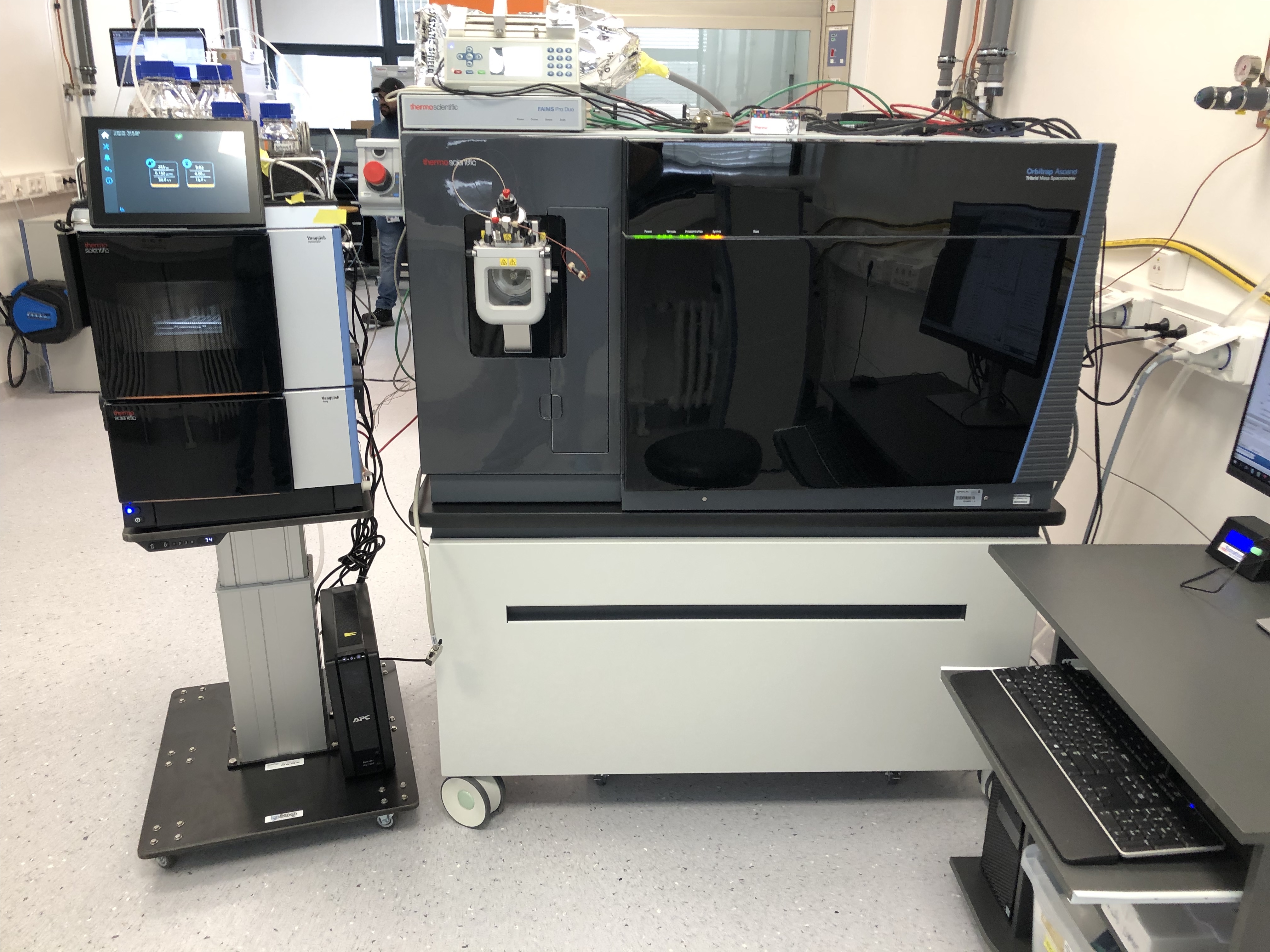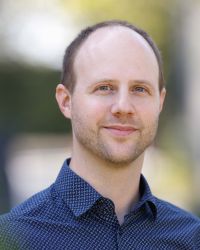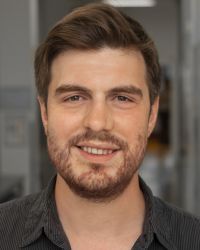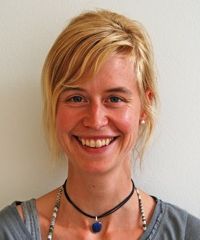Mass Spectrometry
At IBC2, we maintain a proteomics platform allowing our researchers to quantitatively describe signaling networks and to determine how components of signaling complexes are modified in response to pathway perturbations. We perform complementary qualitative and quantitative MS approaches for identification and quantitation of proteins and their post-translational modifications (PTMs, e.g. phosphorylation and ubiquitination), both at small (e.g. interactomes) and large (whole cell- or subcellular proteome) scale.
In general, we follow the so-called bottom-up approach: protein samples are first treated with proteases (e.g. Trypsin and/or LysC) and then analyzed by LC-MS/MS for identification and quantification of the resulting peptides and thus the underlying proteins. Besides label-free protein quantitation based on summed peak intensities of identified peptides, we take advantage of various labelling techniques, such as Tandem Mass Tag (TMT) reagents or Stable Isotope Labelling using Amino acids in Cell culture (SILAC), providing higher throughput and/or more accurate quantification. The generated spectral data is mostly analyzed using MaxQuant (MPI Martinsried) and Proteome Discoverer (Thermo Scientific) in order to obtain the list of identified proteins and their abundances in the samples.
 |
Q Exactive HF
 |
In 2016, we acquired this quadrupole-Orbitrap with an ultra-high-field analyzer as part of the Z project of SFB 1177 (Molecular and Functional Characterization of Selective Autophagy). It provides high sensitivity and acquisition speed for complex samples, especially in conjunction with the hyphenated UHPLC which allows the use of smaller column particles and longer columns due to higher pressure resistance of the fluidics (up to 1200 bar).
Orbitrap Fusion LUMOS
 |
Since November 2018, the unit houses an Orbitrap Fusion Lumos mass spectrometer, which was partially funded by the DFG (FUGG 161/922-1). This so-called “Tribrid”-MS, adding a third mass analyzer (ion trap) to the above-mentioned quadrupole-Orbitrap configuration, allows us to perform SPS-MS3 analyses providing increased accuracy for TMT-based quantitative proteomics experiments. As for the Q Exactive HF, it is coupled to an EASY nLC 1200 for high sensitivity chromatographic separations.
Orbitrap ASCEND
 |
The Orbitrap ASCEND mass spectrometer was installed in December 2022 as the first of its kind in Central Europe. It is the latest addition to the “Tribrid”-MS family, providing increased sensitivity and scan speed and allows us to couple the SPS-MS3 analyses with real-time database searches further improving proteome coverage and/or instrument time efficiency as well as quantification accuracy in TMT-based experiments. Moreover, the front end can be equipped with a High Field Asymetric Waveform Ion Mobility Spectrometry (FAIMS) interface removing background noise and adding another dimension of separation for decreased isolation interference. High sensitive and robust chromatographic peptide separation from nano- to microliter flow rates is achieved with a VanquishNeo UPLC.
This LC-MS system was funded by the European Fonds for regional development as part of the reaction of the EU to the COVID-19-Pandemic. (EFRE) 2014 bis 2020 (IWB-EFRE-Programm Hessen) – 20008763.
Two DIONEX U3000 HPLC
(one analytical, one micro) with fraction collection option
 |
Used to prefractionate peptides using highPh-reversed phase chromatography for increased coverage of identified proteins and PTM-sites in proteomics samples.
If you wish to set up a new collaboration with us, or are planning mass spectrometry experiments as part of the SFB 1177, always contact us before starting the experiments.
Members of the SFB 1177 with projects requiring MS analysis should contact our service platform team for a first consultation via email. Afterwards, please register to MS Portal and complete the sample submission form.
For external researchers use of the MS platform is possible on the basis of collaboration. Please contact Christian Münch or one of the IBC2 group leaders with whom you wish to collaborate directly to discuss the options.
Prof. Dr. Christian Münch
Christian Münch is endowed Lichtenberg-Professor of Molecular Systems Medicine and Director of the Institute of Molecular Systems Medicine as well as Director of the Center for Functional Proteomics at Goethe University Frankfurt. His main research interests focus on cellular stress responses to mitochondrial protein misfolding, infection and disease. Besides biochemical and molecular biology methods, his laboratory applies and develops proteomics methods to measure cellular dynamics after stress on a systems biology level. One major goal is to combine molecular with global information to gain a cell-wide understanding of cellular changes upon stress.
He studied Biochemistry at the University of Tübingen and the Max Planck Institutes in Martinsried and Tübingen (Germany). He obtained his PhD from the University of Cambridge (UK), working on protein aggregation and prion-like processes in neurodegenerative diseases with Anne Bertolotti at the Laboratory of Molecular Biology. For his postdoctoral work, Christian joined Wade Harper’s laboratory at Harvard Medical School to study cellular protein quality control and the mitochondrial unfolded protein response. From 2016-2024, Christian was an independent group leader and from 2023 Endowed Lichtenberg-Professor at the Institute of Biochemistry 2 at Goethe University Frankfurt. In 2024, Christian became full professor and director of the Institute of Molecular Systems Medicine.
For his work, Christian received two ERC Grants, an Emmy Noether Grant and won a number of prizes, the British Neuroscience Association Postgraduate Award (2011), Johanna Quandt Young Academy Science Funding Award (2018), the Aventis Foundation Bridge Award (2019), the Binder Innovation Prize of the German Society for Cell Biology (DGZ, 2020), and the Otto Meyerhof Award of the German Society for Biochemistry and Molecular Biology (GBM, 2021). Christian is an EMBO Young Investigator. He serves in the steering committees of the BMBF Cluster4Future Proxidrugs, Collaborative Research Center 1177 Selective Autophagy, Fraunhofer Leistungszentrum TheraNova, the Excellence Cluster Initiative EMTHERA, the IMPRS Graduate School on Cellular Biophysics, the Transregio cluster 387 Functionalizing the Ubiquitin System against Cancer, and in the editorial board of the Journal of Cellular Biochemistry and the Selection Committee for Humboldt Research Fellowships.
David Krause
IT System Administrator
Datacenter Management
Networks & Servers Administration
Web & Databases Development
IT Systems Security
Martin Adrian-Allgood
In 2012, Martin graduated as Biological Technical Assistant (BTA) in Koblenz and started working in the Kerschensteiner laboratory at the Institute of Clinical Neuroimmunology in Munich focusing on protein production for the MS research. From 2016 till 2019, he was part of the research group Schmidt at the Institute for Microscopic Anatomy and Neurobiology in Mainz, gaining further experience in the production and purification of proteins for cancer research. In 2020, Martin joined to support the Protein Quality Control Group of Christian Münch and the Center for Functional Proteomics
Sánchez-Martín, P., Kriegenburg, F., Alves, L., Adam, J., Elsaesser, J., Babic, R., Mancilla, H., Licheva, M., Tascher, G., Münch, C., Eimer, S., & Kraft, C.. ULK1-mediated phosphorylation regulates the conserved role of YKT6 in autophagy. Journal of cell science 2023, 136(3), jcs260546.
Hertel, A., Alves, L. M., Dutz, H., Tascher, G., Bonn, F., Kaulich, M., Dikic, I., Eimer, S., Steinberg, F., & Bremm, A.. USP32-regulated LAMTOR1 ubiquitination impacts mTORC1 activation and autophagy induction. Cell reports 2022, 41(10), 111653.
Merline, R., Rödig, H., Zeng-Brouwers, J., Poluzzi, C., Tascher, G., Michaelis, J., Lopez-Mosqueda, J., Rhiner, A., Huber, L. S., Diehl, V., Dikic, I., Kögel, D., Münch, C., Wygrecka, M., & Schaefer, L.. A20 binding and inhibitor of nuclear factor kappa B (NF-κB)-1 (ABIN-1): a novel modulator of mitochondrial autophagy. American journal of physiology and Cell physiology 2023, 324(2), C339–C352.
Koschade, S. E., Tascher, G., Parmar, B. S., Brandts, C. H., & Münch, C.. SpinTip: A Simple, Robust, and Versatile Preanalytical Method for Microscale Suspension Cell Proteomics. Journal of proteome research 2022, 21(11), 2827–2835.
Schmitt, D., Bozkurt, S., Henning-Domres, P., Huesmann, H., Eimer, S., Bindila, L., Behrends, C., Boyle, E., Wilfling, F., Tascher, G., Münch, C., Behl, C., & Kern, A.. Lipid and protein content profiling of isolated native autophagic vesicles. EMBO reports 2022, 23(12), e53065.
Koschade, S. E., Klann, K., Shaid, S., Vick, B., Stratmann, J. A., Thölken, M., Meyer, L. M., Nguyen, T. D., Campe, J., Moser, L. M., Hock, S., Baker, F., Meyer, C. T., Wempe, F., Serve, H., Ullrich, E., Jeremias, I., Münch, C., & Brandts, C. H.. Translatome proteomics identifies autophagy as a resistance mechanism to on-target FLT3 inhibitors in acute myeloid leukemia. Leukemia 2022, 36(10), 2396–2407.
Schäfer, J. A., Bozkurt, S., Michaelis, J. B., Klann, K., & Münch, C.. Global mitochondrial protein import proteomics reveal distinct regulation by translation and translocation machinery. Molecular cell 2022, 82(2), 435–446.e7.
Gama-Brambila RA, Chen J, Zhou J, Tascher G, Münch C, Cheng X A PROTAC targets splicing factor 3B1. Cell Chem Biol 2021.
Hahn M, Covarrubias-Pinto A, Herhaus L, Satpathy S, Klann K, Boyle KB, Münch C, Rajalingam K, Randow F, Choudhary C, Dikic I SIK2 orchestrates actin-dependent host response upon infection. Proc Natl Acad Sci U S A 2021. 118 (19).
Klann K, Tascher G, Münch C Virus systems biology: Proteomics profiling of dynamic protein networks during infection. Adv Virus Res 2021. 109 1-29.
Geßner A, Koch B, Klann K, Fuhrmann DC, Farmand S, Schubert R, Münch C, Geiger H, Baer PC Characterization of Extracellular Vesicles from Preconditioned Human Adipose-Derived Stromal/Stem Cells. Int J Mol Sci 2021. 22 (6).
Schwich OD, Blümel N, Keller M, Wegener M, Setty ST, Brunstein ME, Poser I, Mozos IRL, Suess B, Münch C, McNicoll F, Zarnack K, Müller-McNicoll M SRSF3 and SRSF7 modulate 3'UTR length through suppression or activation of proximal polyadenylation sites and regulation of CFIm levels. Genome Biol 2021. 22 (1) 82.
Meyer N, Henkel L, Linder B, Zielke S, Tascher G, Trautmann S, Geisslinger G, Münch C, Fulda S, Tegeder I, Kögel D Autophagy activation, lipotoxicity and lysosomal membrane permeabilization synergize to promote pimozide- and loperamide-induced glioma cell death. Autophagy 2021. 1-20.
Güllülü Ö, Hehlgans S, Mayer BE, Gößner I, Petraki C, Hoffmann M, Dombrowsky MJ, Kunzmann P, Hamacher K, Strebhardt K, Fokas E, Rödel C, Münch C, Rödel F A Spatial and Functional Interaction of a Heterotetramer Survivin-DNA-PKcs Complex in DNA Damage Response. Cancer Res 2021. 81 (9) 2304-2317.
Hiebel C, Stürner E, Hoffmeister M, Tascher G, Schwarz M, Nagel H, Behrends C, Münch C, Behl C BAG3 Proteomic Signature under Proteostasis Stress. Cells 2020. 9 (11).
Bojkova D, Bechtel M, McLaughlin KM, McGreig JE, Klann K, Bellinghausen C, Rohde G, Jonigk D, Braubach P, Ciesek S, Münch C, Wass MN, Michaelis M, Cinatl J Aprotinin Inhibits SARS-CoV-2 Replication. Cells 2020. 9 (11).
Klann K, Bojkova D, Tascher G, Ciesek S, Münch C, Cinatl J Growth Factor Receptor Signaling Inhibition Prevents SARS-CoV-2 Replication. Mol Cell 2020. 80 (1) 164-174.e4.
McLaughlin KM, Bechtel M, Bojkova D, Münch C, Ciesek S, Wass MN, Michaelis M, Cinatl J COVID-19-Related Coagulopathy-Is Transferrin a Missing Link? Diagnostics (Basel) 2020. 10 (8).
Osthues T, Zimmer B, Rimola V, Klann K, Schilling K, Mathoor P, Angioni C, Weigert A, Geisslinger G, Münch C, Scholich K, Sisignano M The Lipid Receptor G2A (GPR132) Mediates Macrophage Migration in Nerve Injury-Induced Neuropathic Pain. Cells 2020. 9 (7).
Klann K, Münch C Instrument Logic Increases Identifications during Mutliplexed Translatome Measurements. Anal Chem 2020. 92 (12) 8041-8045.
Bojkova D, Klann K, Koch B, Widera M, Krause D, Ciesek S, Cinatl J, Münch C Proteomics of SARS-CoV-2-infected host cells reveals therapy targets. Nature 2020. 583 (7816) 469-472.
Key J, Maletzko A, Kohli A, Gispert S, Torres-Odio S, Wittig I, Heidler J, Bárcena C, López-Otín C, Lei Y, West AP, Münch C, Auburger G Loss of mitochondrial ClpP, Lonp1, and Tfam triggers transcriptional induction of Rnf213, a susceptibility factor for moyamoya disease. Neurogenetics 2020. 21 (3) 187-203.
Engel AL, Lorenz NI, Klann K, Münch C, Depner C, Steinbach JP, Ronellenfitsch MW, Luger AL Serine-dependent redox homeostasis regulates glioblastoma cell survival. Br J Cancer 2020. 122 (9) 1391-1398.
Prieto-Garcia C, Hartmann O, Reissland M, Braun F, Fischer T, Walz S, Schülein-Völk C, Eilers U, Ade CP, Calzado MA, Orian A, Maric HM, Münch C, Rosenfeldt M, Eilers M, Diefenbacher ME Maintaining protein stability of ∆Np63 via USP28 is required by squamous cancer cells. EMBO Mol Med 2020. 12 (4) e11101.
Klann K, Tascher G, Münch C Functional Translatome Proteomics Reveal Converging and Dose-Dependent Regulation by mTORC1 and eIF2α. Mol Cell 2020. 77 (4) 913-925.e4.
Pitzius S, Osterburg C, Gebel J, Tascher G, Schäfer B, Zhou H, Münch C, Dötsch V TA*p63 and GTAp63 achieve tighter transcriptional regulation in quality control by converting an inhibitory element into an additional transactivation domain. Cell Death Dis 2019. 10 (10) 686.
Key J, Mueller AK, Gispert S, Matschke L, Wittig I, Corti O, Münch C, Decher N, Auburger G Ubiquitylome profiling of Parkin-null brain reveals dysregulation of calcium homeostasis factors ATP1A2, Hippocalcin and GNA11, reflected by altered firing of noradrenergic neurons. Neurobiol Dis 2019. 127 114-130.
Nguyen TD, Shaid S, Vakhrusheva O, Koschade SE, Klann K, Thölken M, Baker F, Zhang J, Oellerich T, Sürün D, Derlet A, Haberbosch I, Eimer S, Osiewacz HD, Behrends C, Münch C, Dikic I, Brandts CH Loss of the selective autophagy receptor p62 impairs murine myeloid leukemia progression and mitophagy. Blood 2019. 133 (2) 168-179.
Yamano K, Wang C, Sarraf SA, Münch C, Kikuchi R, Noda NN, Hizukuri Y, Kanemaki MT, Harper W, Tanaka K, Matsuda N, Youle RJ Endosomal Rab cycles regulate Parkin-mediated mitophagy. Elife 2018. 7.
Wiechmann S, Gärtner A, Kniss A, Stengl A, Behrends C, Rogov VV, Rodriguez MS, Dötsch V, Müller S, Ernst A. Site-specific inhibition of the small ubiquitin-like modifier (SUMO)-conjugating enzyme Ubc9 selectively impairs SUMO chain formation. J Biol Chem. 2017 Sep 15;292(37):15340-15351.
Polajnar M, Dietz MS, Heilemann M, Behrends C. Expanding the host cell ubiquitylation machinery targeting cytosolic Salmonella. EMBO Rep. 2017 Sep;18(9):1572-1585.
Aguilera-Gomez A, Zacharogianni M, van Oorschot MM, Genau H, Grond R, Veenendaal T, Sinsimer KS, Gavis EA, Behrends C, Rabouille C. Phospho-Rasputin Stabilization by Sec16 Is Required for Stress Granule Formation upon Amino Acid Starvation. Cell Rep. 2017 Aug 29;20(9):2277.
Ilina EI, Armento A, Sanchez LG, Reichlmeir M, Braun Y, Penski C, Capper D, Sahm F, Jennewein L, Harter PN, Zukunft S, Fleming I, Schulte D, Le Guerroué F, Behrends C, Ronellenfitsch MW, Naumann U, Mittelbronn M. Effects of soluble CPE on glioma cell migration are associated with mTOR activation and enhanced glucose flux. Oncotarget. 2017 Jun 27;8(40):67567-67591.
Grumati P, Morozzi G, Hölper S, Mari M, Harwardt MI, Yan R, Müller S, Reggiori F, Heilemann M, Dikic I. Full length RTN3 regulates turnover of tubular endoplasmic reticulum via selective autophagy. Elife. 2017 Jun 15;6. pii: e25555.
Nayak A, Reck A, Morsczeck C, Müller S. Flightless-I governs cell fate by recruiting the SUMO isopeptidase SENP3 to distinct HOX genes. Epigenetics Chromatin. 2017 Mar 23;10:15.
Drané P, Brault ME, Cui G, Meghani K, Chaubey S, Detappe A, Parnandi N, He Y, Zheng XF, Botuyan MV, Kalousi A, Yewdell WT, Münch C, Harper JW, Chaudhuri J, Soutoglou E, Mer G, Chowdhury D. TIRR regulates 53BP1 by masking its histone methyl-lysine binding function. Nature. 2017 Mar 9;543(7644):211-216.
Jung J, Nayak A, Schaeffer V, Starzetz T, Kirsch AK, Müller S, Dikic I, Mittelbronn M, Behrends C. Multiplex image-based autophagy RNAi screening identifies SMCR8 as ULK1 kinase activity and gene expression regulator. Elife. 2017 Feb 14;6. pii: e23063.
Reiterer V, Figueras-Puig C, Le Guerroue F, Confalonieri S, Vecchi M, Jalapothu D, Kanse SM, Deshaies RJ, Di Fiore PP, Behrends C, Farhan H. The pseudophosphatase STYX targets the F-box of FBXW7 and inhibits SCFFBXW7 function. EMBO J. 2017 Feb 1;36(3):260-273.
Fiskin E, Bhogaraju S, Herhaus L, Kalayil S, Hahn M, Dikic I. Structural basis for the recognition and degradation of host TRIM proteins by Salmonella effector SopA. Nat Commun. 2017 Jan 13;8:14004.
Bhogaraju S, Kalayil S, Liu Y, Bonn F, Colby T, Matic I, Dikic I. Phosphoribosylation of Ubiquitin Promotes Serine Ubiquitination and Impairs Conventional Ubiquitination. Cell. 2016 Dec 1;167(6):1636-1649.e13.
Yang W, Nagasawa K, Münch C, Xu Y, Satterstrom K, Jeong S, Hayes SD, Jedrychowski MP, Vyas FS, Zaganjor E, Guarani V, Ringel AE, Gygi SP, Harper JW, Haigis MC. Mitochondrial Sirtuin Network Reveals Dynamic SIRT3-Dependent Deacetylation in Response to Membrane Depolarization. Cell. 2016 Nov 3;167(4):985-1000.e21.
Raman N, Weir E, Müller S. The AAA ATPase MDN1 Acts as a SUMO-Targeted Regulator in Mammalian Pre-ribosome Remodeling. Mol Cell. 2016 Nov 3;64(3):607-615.
Kunz K, Wagner K, Mendler L, Hölper S, Dehne N, Müller S. SUMO Signaling by Hypoxic Inactivation of SUMO-Specific Isopeptidases. Cell Rep. 2016 Sep 13;16(11):3075-3086.
Mauthe M, Langereis M, Jung J, Zhou X, Jones A, Omta W, Tooze SA, Stork B, Paludan SR, Ahola T, Egan D, Behrends C, Mokry M, de Haan C, van Kuppeveld F, Reggiori F. An siRNA screen for ATG protein depletion reveals the extent of the unconventional functions of the autophagy proteome in virus replication. J Cell Biol. 2016 Aug 29;214(5):619-35.
Münch C, Harper JW. Mitochondrial unfolded protein response controls matrix pre-RNA processing and translation. Nature. 2016 Jun 30;534(7609):710-3.
Fiskin E, Bionda T, Dikic I, Behrends C. Global Analysis of Host and Bacterial Ubiquitinome in Response to Salmonella Typhimurium Infection. Mol Cell. 2016 Jun 16;62(6):967-981.
Richter B, Sliter DA, Herhaus L, Stolz A, Wang C, Beli P, Zaffagnini G, Wild P, Martens S, Wagner SA, Youle RJ, Dikic I. Phosphorylation of OPTN by TBK1 enhances its binding to Ub chains and promotes selective autophagy of damaged mitochondria. Proc Natl Acad Sci U S A. 2016 Apr 12;113(15):4039-44.
Lamb CA, Nühlen S, Judith D, Frith D, Snijders AP, Behrends C, Tooze SA. TBC1D14 regulates autophagy via the TRAPP complex and ATG9 traffic. EMBO J. 2016 Feb 1;35(3):281-301.
Jung J, Genau HM, Behrends C. Amino Acid-Dependent mTORC1 Regulation by the Lysosomal Membrane Protein SLC38A9. Mol Cell Biol. 2015 Jul;35(14):2479-94.
Genau HM, Huber J, Baschieri F, Akutsu M, Dötsch V, Farhan H, Rogov V, Behrends C. CUL3-KBTBD6/KBTBD7 ubiquitin ligase cooperates with GABARAP proteins to spatially restrict TIAM1-RAC1 signaling. Mol Cell. 2015 Mar 19;57(6):995-1010.
McEwan DG, Popovic D, Gubas A, Terawaki S, Suzuki H, Stadel D, Coxon FP, Miranda de Stegmann D, Bhogaraju S, Maddi K, Kirchof A, Gatti E, Helfrich MH, Wakatsuki S, Behrends C, Pierre P, Dikic I. PLEKHM1 regulates autophagosome-lysosome fusion through HOPS complex and LC3/GABARAP proteins. Mol Cell. 2015 Jan 8;57(1):39-54.
Raman N, Nayak A, Muller S. mTOR signaling regulates nucleolar targeting of the SUMO-specific isopeptidase SENP3. Mol Cell Biol. 2014 Dec;34(24):4474-84.
Spang N, Feldmann A, Huesmann H, Bekbulat F, Schmitt V, Hiebel C, Koziollek-Drechsler I, Clement AM, Moosmann B, Jung J, Behrends C, Dikic I, Kern A, Behl C. RAB3GAP1 and RAB3GAP2 modulate basal and rapamycin-induced autophagy. Autophagy. 2014 10(12):2297-309.
Lu J, He L, Behrends C, Araki M, Araki K, Jun Wang Q, Catanzaro JM, Friedman SL, Zong WX, Fiel MI, Li M, Yue Z. NRBF2 regulates autophagy and prevents liver injury by modulating Atg14L-linked phosphatidylinositol-3 kinase III activity. Nat Commun. 2014 May 22;5:3920.
Popovic D, Akutsu M, Novak I, Harper JW, Behrends C, Dikic I. Rab GTPase-activating proteins in autophagy: regulation of endocytic and autophagy pathways by direct binding to human ATG8 modifiers. Mol Cell Biol. 2012 May;32(9):1733-44.
Behrends C, Sowa ME, Gygi SP, Harper JW. Network organization of the human autophagy system. Nature. 2010 Jul 1;466(7302):68-76.
Ordureau, A., Münch, C., and Harper, J.W. (2015). Quantifying Ubiquitin Signaling. Mol. Cell 58, 660–676.



